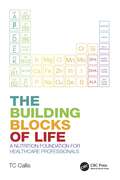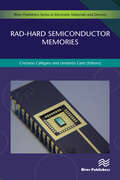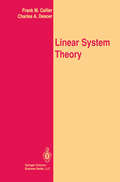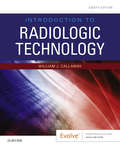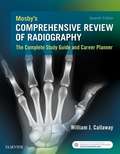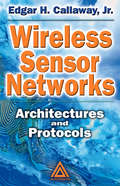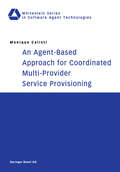- Table View
- List View
Die Flußverdrängung und Flußverlagerung im verzweigten magnetischen Kreis und ihre Bedeutung für den Induktionszähler: Von der Technischen Hochschule zu Darmstadt zur Erlangung der Würde eines Doktor-Ingenieurs genehmigte Dissertation
by Albert CallsenDieser Buchtitel ist Teil des Digitalisierungsprojekts Springer Book Archives mit Publikationen, die seit den Anfängen des Verlags von 1842 erschienen sind. Der Verlag stellt mit diesem Archiv Quellen für die historische wie auch die disziplingeschichtliche Forschung zur Verfügung, die jeweils im historischen Kontext betrachtet werden müssen. Dieser Titel erschien in der Zeit vor 1945 und wird daher in seiner zeittypischen politisch-ideologischen Ausrichtung vom Verlag nicht beworben.
Fundamentals of Materials Science and Engineering: An Integrated Approach
by William D. Callister Jr. David G. RethwischFundamentals of Materials Science and Engineering takes an integrated approach to the sequence of topics – one specific structure, characteristic, or property type is covered in turn for all three basic material types: metals, ceramics, and polymeric materials. This presentation permits the early introduction of non-metals and supports the engineer's role in choosing materials based upon their characteristics. Using clear, concise terminology that is familiar to students, Fundamentals presents material at an appropriate level for both student comprehension and instructors who may not have a materials background.
Fundamentals of Materials Science and Engineering: An Integrated Approach
by William D. Callister Jr. David G. RethwischFundamentals of Materials Science and Engineering: An Integrated Approach, 5th Edition SI Version takes an integrated approach to the sequence of topics – one specific structure, characteristic, or property type is covered in turn for all three basic material types: metals, ceramics, and polymeric materials. This presentation permits the early introduction of non-metals and supports the engineer's role in choosing materials based upon their characteristics. Using clear, concise terminology that is familiar to students, Fundamentals presents material at an appropriate level for both student comprehension and instructors who may not have a materials background.
Fundamentals of Materials Science and Engineering: An Integrated Approach (Wiley Plus Products Ser.)
by William Callister David RethwischMaterials Science and Engineering
by William D. Callister Jr. David G. RethwischMaterials Science and Engineering, 9th Edition provides engineers with a strong understanding of the three primary types of materials and composites, as well as the relationships that exist between the structural elements of materials and their properties. The relationships among processing, structure, properties, and performance components for steels, glass-ceramics, polymer fibers, and silicon semiconductors are explored throughout the chapters.
Materials Science and Engineering, Enhanced eText: An Introduction (Wiley Plus Products Ser.)
by William D. Callister Jr. David G. RethwischMaterials Science and Engineering: An Introduction promotes student understanding of the three primary types of materials (metals, ceramics, and polymers) and composites, as well as the relationships that exist between the structural elements of materials and their properties.
Materialwissenschaften und Werkstofftechnik: Eine Einführung (Wiley-VCH-Lehrbuchkollektion 1)
by William D. Callister Jr. David G. RethwischDer 'Callister' bietet den gesamten Stoff der Materialwissenschaften und Werkstofftechnik für Studium und Prüfungsvorbereitung. Hervorragend aufbereitet und in klarer, prägnanter Sprache wird das gesamte Fachgebiet anschaulich dargestellt. Das erprobte didaktische Konzept zielt ab auf 'Verständnis vor Formalismus' und unterstützt den Lernprozess der Studierenden: * ausformulierte Lernziele * regelmäßig eingestreute Verständnisfragen zum gerade vermittelten Stoff * Kapitelzusammenfassungen mit Lernstoff, Gleichungen, Schlüsselwörtern und Querverweisen auf andere Kapitel * durchgerechnete Beispiele, Fragen und Antworten sowie Aufgaben und Lösungen * Exkurse in die industrielle Anwendung * an den deutschen Sprachraum angepasste Einheiten und Werkstoffbezeichnungen * durchgehend vierfarbig illustriert * Verweise auf elektronisches Zusatzmaterial Der 'Callister' ist ein Muss für angehende Materialwissenschaftler und Werkstofftechniker an Universitäten und Fachhochschulen - und ideal geeignet für Studierende aus Physik, Chemie, Maschinenbau und Bauingenieurwesen, die sich mit den Grundlagen des Fachs vertraut machen möchten.
Materialwissenschaften und Werkstofftechnik: Eine Einführung (Wiley-VCH-Lehrbuchkollektion 1)
by William D. Callister Jr. David G. RethwischDer 'Callister' bietet den gesamten Stoff der Materialwissenschaften und Werkstofftechnik für Studium und Prüfungsvorbereitung. Hervorragend aufbereitet und in klarer, prägnanter Sprache wird das gesamte Fachgebiet anschaulich dargestellt. Das erprobte didaktische Konzept zielt ab auf 'Verständnis vor Formalismus' und unterstützt den Lernprozess der Studierenden: * ausformulierte Lernziele * regelmäßig eingestreute Verständnisfragen zum gerade vermittelten Stoff * Kapitelzusammenfassungen mit Lernstoff, Gleichungen, Schlüsselwörtern und Querverweisen auf andere Kapitel * durchgerechnete Beispiele, Fragen und Antworten sowie Aufgaben und Lösungen * Exkurse in die industrielle Anwendung * an den deutschen Sprachraum angepasste Einheiten und Werkstoffbezeichnungen * durchgehend vierfarbig illustriert * Verweise auf elektronisches Zusatzmaterial Der 'Callister' ist ein Muss für angehende Materialwissenschaftler und Werkstofftechniker an Universitäten und Fachhochschulen - und ideal geeignet für Studierende aus Physik, Chemie, Maschinenbau und Bauingenieurwesen, die sich mit den Grundlagen des Fachs vertraut machen möchten.
The Building Blocks of Life: A Nutrition Foundation for Healthcare Professionals
by TC CallisWithin the United Kingdom (UK), most mainstream healthcare practitioners receive little or no nutrition education during their years of training. As a consequence, the understanding of nutrition amongst primary care practitioners such as general practitioners, pharmacists, midwives, and practice nurses is limited and is largely focused on energy consumption and obesity. There is little knowledge of the wealth of micronutrients that underpin health, nor of the ticking timebomb of insufficient intakes of those micronutrients amongst a significant proportion of the population in the UK.The Building Blocks of Life: A Nutrition Foundation for Healthcare Professionals is a step towards redressing that balance. It sets out an informative and engaging narrative on how and why nutrition is the basis for good health. It discusses UK-specific issues with regards to diet and intakes of vitamins, minerals, essential fatty acids and other micronutrients. It also raises concerns about the potential negative health implications of the generally poor UK diet and suggests ways that healthcare practitioners can support patients in improving their long-term health outlook.Nutrition policy in the UK needs to be dragged into the 21st century and this book sets out evidence-based arguments which challenge current public health myths such as the idea that 10 micrograms of vitamin D is all anyone needs or the messaging around the consumption of saturated fat vs highly processed seed oils or that everyone can get all the nutrients they need from a varied and balanced diet.Although The Building Blocks of Life: A Nutrition Foundation for Healthcare Professionals focuses on concerns around poor diet and the consequent micronutrient inadequacies in the UK, the nutritional detail is relevant no matter where you are in the world. Everyone eats, all the time. It is time that mainstream medicine looked towards food as both a cause and a solution to many of the chronic degenerative conditions that plague modern life.
The Building Blocks of Life: A Nutrition Foundation for Healthcare Professionals
by TC CallisWithin the United Kingdom (UK), most mainstream healthcare practitioners receive little or no nutrition education during their years of training. As a consequence, the understanding of nutrition amongst primary care practitioners such as general practitioners, pharmacists, midwives, and practice nurses is limited and is largely focused on energy consumption and obesity. There is little knowledge of the wealth of micronutrients that underpin health, nor of the ticking timebomb of insufficient intakes of those micronutrients amongst a significant proportion of the population in the UK.The Building Blocks of Life: A Nutrition Foundation for Healthcare Professionals is a step towards redressing that balance. It sets out an informative and engaging narrative on how and why nutrition is the basis for good health. It discusses UK-specific issues with regards to diet and intakes of vitamins, minerals, essential fatty acids and other micronutrients. It also raises concerns about the potential negative health implications of the generally poor UK diet and suggests ways that healthcare practitioners can support patients in improving their long-term health outlook.Nutrition policy in the UK needs to be dragged into the 21st century and this book sets out evidence-based arguments which challenge current public health myths such as the idea that 10 micrograms of vitamin D is all anyone needs or the messaging around the consumption of saturated fat vs highly processed seed oils or that everyone can get all the nutrients they need from a varied and balanced diet.Although The Building Blocks of Life: A Nutrition Foundation for Healthcare Professionals focuses on concerns around poor diet and the consequent micronutrient inadequacies in the UK, the nutritional detail is relevant no matter where you are in the world. Everyone eats, all the time. It is time that mainstream medicine looked towards food as both a cause and a solution to many of the chronic degenerative conditions that plague modern life.
Rad-hard Semiconductor Memories
by Cristiano Calligaro Umberto GattiRad-hard Semiconductor Memories is intended for researchers and professionals interested in understanding how to design and make a preliminary evaluation of rad-hard semiconductor memories, making leverage on standard CMOS manufacturing processes available from different silicon foundries and using different technology nodes.In the first part of the book, a preliminary overview of the effects of radiation in space, with a specific focus on memories, will be conducted to enable the reader to understand why specific design solutions are adopted to mitigate hard and soft errors. The second part will be devoted to RHBD (Radiation Hardening by Design) techniques for semiconductor components with a specific focus on memories. The approach will follow a top-down scheme starting from RHBD at architectural level (how to build a rad-hard floor-plan), at circuit level (how to mitigate radiation effects by handling transistors in the proper way) and at layout level (how to shape a layout to mitigate radiation effects).After the description of the mitigation techniques, the book enters in the core of the topic covering SRAMs (synchronous, asynchronous, single port and dual port) and PROMs (based on AntiFuse OTP technologies), describing how to design a rad-hard flash memory and fostering RHBD toward emerging memories like ReRAM. The last part will be a leap into emerging memories at a very early stage, not yet ready for industrial use in silicon but candidates to become an option for the next wave of rad-hard components. Technical topics discussed in the book include: Radiation effects on semiconductor components (TID, SEE) Radiation Hardening by Design (RHBD) Techniques Rad-hard SRAMs Rad-hard PROMs Rad-hard Flash NVMs Rad-hard ReRAMs Rad-hard emerging technologies
Rad-hard Semiconductor Memories
by Cristiano Calligaro Umberto GattiRad-hard Semiconductor Memories is intended for researchers and professionals interested in understanding how to design and make a preliminary evaluation of rad-hard semiconductor memories, making leverage on standard CMOS manufacturing processes available from different silicon foundries and using different technology nodes.In the first part of the book, a preliminary overview of the effects of radiation in space, with a specific focus on memories, will be conducted to enable the reader to understand why specific design solutions are adopted to mitigate hard and soft errors. The second part will be devoted to RHBD (Radiation Hardening by Design) techniques for semiconductor components with a specific focus on memories. The approach will follow a top-down scheme starting from RHBD at architectural level (how to build a rad-hard floor-plan), at circuit level (how to mitigate radiation effects by handling transistors in the proper way) and at layout level (how to shape a layout to mitigate radiation effects).After the description of the mitigation techniques, the book enters in the core of the topic covering SRAMs (synchronous, asynchronous, single port and dual port) and PROMs (based on AntiFuse OTP technologies), describing how to design a rad-hard flash memory and fostering RHBD toward emerging memories like ReRAM. The last part will be a leap into emerging memories at a very early stage, not yet ready for industrial use in silicon but candidates to become an option for the next wave of rad-hard components. Technical topics discussed in the book include: Radiation effects on semiconductor components (TID, SEE) Radiation Hardening by Design (RHBD) Techniques Rad-hard SRAMs Rad-hard PROMs Rad-hard Flash NVMs Rad-hard ReRAMs Rad-hard emerging technologies
Modellierung von qualitäts- und effektivitätsbestimmenden Mechanismen beim Laserabtragen (Laser in der Materialbearbeitung)
by Gert CalliesLinear System Theory (Springer Texts in Electrical Engineering)
by Frank M. Callier Charles A. DesoerThis book is the result of our teaching over the years an undergraduate course on Linear Optimal Systems to applied mathematicians and a first-year graduate course on Linear Systems to engineers. The contents of the book bear the strong influence of the great advances in the field and of its enormous literature. However, we made no attempt to have a complete coverage. Our motivation was to write a book on linear systems that covers finite dimensional linear systems, always keeping in mind the main purpose of engineering and applied science, which is to analyze, design, and improve the performance of phy sical systems. Hence we discuss the effect of small nonlinearities, and of perturbations of feedback. It is our on the data; we face robustness issues and discuss the properties hope that the book will be a useful reference for a first-year graduate student. We assume that a typical reader with an engineering background will have gone through the conventional undergraduate single-input single-output linear systems course; an elementary course in control is not indispensable but may be useful for motivation. For readers from a mathematical curriculum we require only familiarity with techniques of linear algebra and of ordinary differential equations.
Traffic Engineering: A Practical Approach (Textbooks in Telecommunication Engineering)
by Franco Callegati Walter Cerroni Carla RaffaelliThis textbook discusses the principles of queuing theory and teletraffic engineering in telecommunication networks. The book lays out the rigorous theoretical background while keeping strong links to practical applications and real-life scenarios. The overall goal of this textbook is to provide students with in-depth and broad understanding of the operational framework of teletraffic problems, and therefore the capability to select the most suitable and effective method to solve traffic engineering problems that may arise in real-life. The student will learn to pick and choose from a spectrum of tools, ranging from the simplest mathematical treatment to sophisticated models. The book features practical examples derived from real life, presented and discussed, establishing the links with the theoretical results. Pedagogical materials include end-of-chapter exercises and problems.
Einstein For Dummies
by Carlos I. CalleGenius demystified, the Dummies way! In 1905, Albert Einstein revolutionized modern physics with his theory of relativity. He went on to become a twentieth-century icon-a man whose name and face are synonymous with "genius." Now, at last, ordinary readers can explore Einstein's life and work in this new For Dummies guide. Physicist Carlos Calle chronicles Einstein's career and explains his work-including the theories of special and general relativity-in language that anyone can understand. He shows how Einstein's discoveries affected everything from the development of the atom bomb to the theory of quantum mechanics. He sheds light on Einstein's personal life and beliefs, including his views on religion and politics. And he shows how Einstein's work continues to affect our world today, from nuclear power to space travel to artificial intelligence.
Introduction to Radiologic Technology - E-Book
by William J. CallawayGet an introduction to the radiologic technology profession with this solid text! Covering everything a beginning radiography student needs to know, Introduction to Radiologic Technology, 8th Edition lays the groundwork for a successful career. It includes coverage of the coursework required, basic learning skills, a historical perspective on radiology, and insight into key topics such as the language of medicine, digital imaging, patient care, and radiation safety. This book also includes the latest changes in the registry exam and a discussion of the radiographer’s role in the practice setting and opportunities for advancement.A clear, easy-to-read style does not assume you have prior knowledge of the subject matter. Critical thinking skills are highlighted, with four important steps to take in assessing situations and making informed decisions.Guidelines for a solid radiography career foundation discuss customer service, ethics and professionalism, and professional organizations.Thorough introduction to radiologic technology includes a concise overview of what you can expect in your coursework.Cultural diversity coverage orients you to the challenge of dealing with patients from different cultures in the medical environment. NEW! Updated career advancement opportunities and newest medical terminology include just the right amount detail for new radiographers.NEW! Incorporation of SI units of measurement accurately depict current practice standards.
Mosby's Comprehensive Review of Radiography - E-Book: The Complete Study Guide and Career Planner
by William J. CallawayA complete review for the Registry exam, Mosby's Comprehensive Review of Radiography: The Complete Study Guide and Career Planner, 6th Edition covers the five major subject areas of the ARRT exam in radiography. It is also an effective study guide for many radiography courses! Written in outline format, each review of a subject is followed by questions related specifically to that area. Two mock ARRT exams are included in the book, and online exams include a pool of over 1,400 review questions that may be randomly combined to generate a virtually limitless number of mock ARRT exams. From noted radiography educator William J. Callaway, this edition also provides advice on writing resumes and cover letters, interviewing, employer expectations, and continuing education requirements to help you make the transition to a successful career.Review of the five major subject areas covered on the ARRT exam, in an outline format, helps you concentrate on the most important information. Over 2,400 review questions in the book and online offer practice with a multiple-choice format similar to the ARRT exam. Thorough coverage of digital and computed radiography reflects the increased emphasis of these topics on the Registry exam. Online mock exams let you practice in tutorial mode -- with immediate feedback after each question -- or in exam mode, with feedback only after you complete the entire test. Online study tools include study tips for difficult questions and electronic flashcards with formulas, key terms, and important topics. Rationales for correct and incorrect answers are included in the appendix. Career preparation advice includes writing resumes and cover letters, tips for interviewing, a look at what employers expect, career advancement, basic financial planning, and continuing education requirements. Updates reflect the latest ARRT exam changes with expanded coverage of computed and direct radiography, a review of computed tomography along with questions, and an additional 200-question exam in the Review Activities and Challenge Tests chapter. Online access to mock exams. Job search preparation includes tips on how to submit online applications and resumes.
Mosby's Comprehensive Review of Radiography - E-Book: The Complete Study Guide and Career Planner
by William J. CallawayPrepare for success on the ARRT certification exam! Mosby's Comprehensive Review of Radiography: The Complete Study Guide & Career Planner, 7th Edition offers a complete, outline-style review of the major subject areas covered on the ARRT exam in radiography. Each review section is followed by a set of questions testing your knowledge of that subject area. Two mock ARRT exams are included in the book, and over 1,400 online review questions may be randomly combined to generate a virtually limitless number of practice exams. From noted radiography educator and lecturer William J. Callaway, this book is also an ideal study guide for the classroom and an expert resource for use in launching your career. Over 2,400 review questions are provided in the book and online, offering practice in a multiple-choice format similar to the ARRT exam. Outline-style review covers the major subject areas covered on the ARRT exam, and helps you focus on the most important information.Coverage of digital imaging reflects the increased emphasis of this topic on the Registry exam.Career planning advice includes examples of resumes and cover letters, interviewing tips, a look at what employers expect, online submission of applications, salary negotiation, career advancement, and continuing education requirements.Online mock exams let you answer more than 1,400 questions in study mode — with immediate feedback after each question, or in exam mode — with feedback only after you complete the entire test.Key Review Points are included in every chapter, highlighting the ‘need to know’ content for exam and clinical success.Rationales for correct and incorrect answers are included in the appendix.Electronic flashcards are available online, to help you memorize formulas, key terms, and other key information.Online test scores are date-stamped and stored, making it easy to track your progress. UPDATES reflect the latest ARRT exam changes, providing the content that you need to know in order to pass the exam. NEW! Image labeling exercises prepare you for the labeling questions on the ARRT exam.NEW! Colorful design highlights essential information and makes the text easier to read.
Mosby's Comprehensive Review of Radiography - E-Book: Mosby's Comprehensive Review of Radiography - E-Book
by William J. CallawayPass the ARRT certification exam on your first try with this all-in-one review! Mosby's Comprehensive Review of Radiography: The Complete Study Guide & Career Planner, 8th Edition provides a complete, outline-style review of the major subject areas covered on the ARRT examination in radiography. Each review section is followed by a set of questions testing your knowledge of that subject area. Three mock ARRT exams are included in the book, and more than 1,400 online review questions may be randomly combined to generate a virtually limitless number of practice exams. From noted educator and speaker William J. Callaway, this study guide is also ideal for use in radiography courses and in beginning your career as a radiographer. More than 2,300 review questions are provided in the book and on the Evolve website, offering practice in a computer-based, multiple-choice format similar to the ARRT exam. Colorful, outline-style review covers the major subject areas covered on the ARRT exam, and helps you focus on the most important information. Formats for ARRT questions include exhibits, sorted list, multiselect, and combined response. Rationales for correct and incorrect answers are included in the appendix. Key Review Points are included in every chapter, highlighting the need-to-know content for exam and clinical success. Mock exams on the Evolve website let you answer more than 1,200 questions in study mode, with immediate feedback after each question — or in exam mode, with feedback only after you complete the entire test. Career planning advice includes examples of resumes and cover letters, interviewing tips, a look at what employers expect, online submission of applications, salary negotiation, career advancement, and continuing education requirements; in addition, customizable resumes may be downloaded from Evolve. Electronic flashcards are included on Evolve, to help you memorize formulas, key terms, and other key information. Online test scores are date-stamped and stored, making it easy to track your progress. NEW! Updated content is built to the most current ARRT exam content specifications, providing everything you need to prepare for and pass the exam. NEW! Coverage of digital imaging is updated to reflect the importance of this topic on the Registry exam.
Direct-Fed Microbials and Prebiotics for Animals: Science and Mechanisms of Action
by Todd R. Callaway Steven C. RickeIn this exciting update, readers will learn how feeding direct-fed microbials (including eubiotics, postbiotics, prebiotics, and synbiotics) is becoming increasingly widespread during food animal production. Animal production must improve efficiency of growth, and the use of direct-fed microbial and prebiotic additives to domestic animals has become widely accepted and utilized. The benefits of probiotic-type approaches in cattle, pigs, fish, and poultry, include improved general animal health, reduced foodborne pathogen populations, increased growth rate and feed efficiency, improved milk and egg production, and have been reported world-wide. Successes from probiotic approaches in multiple species have ensured their adoption; however, several fundamental questions remain. Early establishment and retention of an ecological balance in the gastrointestinal tract is an important first step for an external biological additive to be effective in young animals, suggesting that some of the benefits of direct-fed microbials may be due to an early establishment of a “normal” native gut microbial population. Research has indicated that the establishment of a normal population can enhance gut epithelial integrity, preventing inflammation and improving animal health. Thus, it is important that we understand the key processes that occur during the establishment of the gut microbial population that can impact gastrointestinal fermentation and provide protection against pathogens of the animals and of human consumers. Knowing how these processes work and how they impact animal energy and protein expenditures can guide further improvements of available and future commercial products. Exciting research opportunities are discussed in this book, examining different characteristics of DFMs that are fed to animals to meet different production demands in different production scenarios (e.g., beef versus dairy versus swine versus fin fish). The advent of molecular and next-generation sequencing offers methods of developing tailored DFMs, and of early detection of successful DFM establishment in the gut. These techniques will further deepen our insight into understanding the microbial population of the gut and how these populations impact animal health, food safety, and sustainability of animal-derived protein production.
Wireless Sensor Networks: Architectures and Protocols (Internet And Communications Ser.)
by Jr., Edgar CallawayBecause they provide practical machine-to-machine communication at a very low cost, the popularity of wireless sensor networks is expected to skyrocket in the next few years, duplicating the recent explosion of wireless LANs. Wireless Sensor Networks: Architectures and Protocols describes how to build these networks, from the layers of the
Wireless Sensor Networks: Architectures and Protocols
by Jr., Edgar CallawayBecause they provide practical machine-to-machine communication at a very low cost, the popularity of wireless sensor networks is expected to skyrocket in the next few years, duplicating the recent explosion of wireless LANs. Wireless Sensor Networks: Architectures and Protocols describes how to build these networks, from the layers of the
An Agent-Based Approach for Coordinated Multi-Provider Service Provisioning (Whitestein Series in Software Agent Technologies and Autonomic Computing)
by Monique CalistiThis book proposes a novel approach to improve multi-provider interactions based on the coordination of autonomous and self-motivated software entities acting on behalf of distinct operators. In addition, a novel way of addressing resource allocation and pricing in a compact framework is made possible by the use of powerful resource abstraction techniques. The book is addressed to researchers in the area of agent technology, automated negotiation, distributed constraint satisfaction, and networking. Furthermore, it should be a valuable resource for both network and service providers
Thermodynamic Modeling and Materials Data Engineering (Data and Knowledge in a Changing World)
by J. P. Caliste A. Truyol Jack H. WestbrookJ.-P. CALISTE, A. TRUYOL AND J. WESTBROOK The Series, "Data and Knowledge in a Changing World", exemplifies CODATA's primary purpose of collecting, from widely different fields, a wealth of information on efficient exploitation of data for progress in science and technology and making that information available to scientists and engineers. A separate and complementary CODATA Reference Series will present Directories of compiled and evaluated data and Glossaries of data-related terms. The present book "Thermodynamic Modeling and Materials Data Engineering" discusses thermodynamic, structural, systemic and heuristic approaches to the modeling of complex materials behavior in condensed phases, both fluids and solids, in order to evaluate their potential applications. Itwas inspired by the Symposium on "Materials and Structural Properties" held during the 14th International CODATA Conference in Chambery, France. The quality of the contributions to this Symposium motivated us to present" a coherent book of interest to the field. Updated contributions inspired by Symposium discussions and selections from other CODATA workshops concerning material properties data and Computer Aided Design combine to highlight the complexity of material data issues on experimental, theoretical and simulation levels Articles were selected for their pertinence in three areas. Complex data leading to interesting developments and tools such as: • new developments in state equations and their applications, • prediction and validation of physical and energy data by group correlations for pure compounds, • modeling and prediction of mixture properties.







